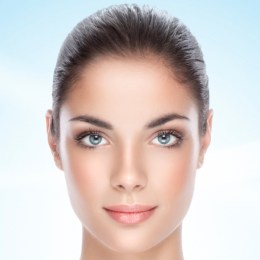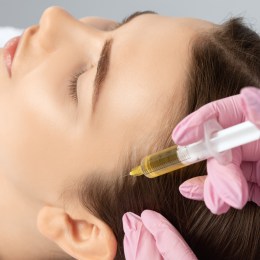A few years ago I had a micro-needling procedure combined with radio frequency to amp up the anti-ageing benefits.
It was uniquely painful – “bouncing off the walls” took on a whole new meaning, although I am reliably informed the treatment protocol has been refined after such feedback and is now significantly more comfortable – and left my skin red raw.
Now, these things I was warned to expect, and the improvements I noticed in the ensuing weeks and months in terms of skin texture and facial firmness were worth it (I had three treatments in all, a month apart; yes, I am a sucker for punishment for the greater cause).
What I was not properly warned about, in my view, was the need for scrupulously pristine handling of my skin and the products to use – and not to use – until it had healed. Nor the possible risks of applying makeup immediately after a procedure that had created myriad micro-perforations on my skin and caused bleeding.
I was offered camouflage makeup in the immediate aftermath which I greedily accepted, as the mirror showed me an image straight from a horror movie.
As I look back now, it was from a compact that had been used to “camouflage” other patients. I have a vague memory of a shared brush being used, but I could be wrong about that.
I thought nothing of it at the time, delighted as I was that the coverage was so good nobody was able to tell that my face was really beet red and I could go straight back to work.
While delighted by the gradual improvements to skin texture and facial tone, some weeks later I was also alarmed to start getting deep-seated congestion, mainly around my chin and jawline, but also on my mid cheeks.
Having suffered adult acne in my late 20s and early 30s I was terrified I was heading down that distressing path again. Indeed, a number of experts I spoke to suggested it was acne caused by over-stimulation.
The spots were slow to dissipate and almost as soon as some had subsided others would pop up in their place.
This persisted for up to 18 months and I developed a habit of picking at and squeezing them in frustration, sometimes without even realising I was doing it, which just made them worse (even infected) and hang around longer, and my face a morass of red splotches followed by post-inflammatory brown ones.
Then for no apparent reason it cleared up within a matter of weeks. That said, the healing began to occur after I started using the excellent DermaQuest Pumpkin Peel Mask two or three times a week at home; a gentle enzyme exfoliant that refines and purifies.
I recently recounted this story to skin care guru Matoyla Kollaras, general manager of Skin Factors, distributor in Australia of Christina Cosmeceuticals and Ahava Dead Sea products.
She shook her head: “No, I can guarantee it wasn’t acne but a chronic infection introduced by poor hygiene or contaminated products.”
I pride myself on my hygiene(!) and I thought back to what could have happened. Then suddenly I remembered the makeup … all became clear.
Since this revelation I have been alert to other stories about how easily skin can become infected after micro-needling (whether with a dermal roller, stamp or pen) and even after dermal fillers and anti-wrinkle injections.
Leading nurse injector Nikki Belle, of Face Today medi clinics in Sydney and Cairns, told SPA+CLINIC that she has heard of a number of instances from peers where even unfiltered tap water being used to wash the face after cosmetic injections can cause infection.
At the recent launch of Fusion Meso into the Australian market, its creator and CEO, chemist Dr Raphaël Duérink, told media attendees that he urges therapists to encourage clients not to apply makeup for up to 48 hours after a treatment that perforates the skin, however superficially (such as Fusion Meso).
However, it’s fair to say that most clients/patients won’t be willing to go bare-faced with redness, bruising et al for that long.
SPA+CLINIC asked Dr Aaron Atia, Co-founder of Skin O2 and Medical Director of Alive Cosmetic Clinics, advice to offer clients after micro-needling or injections at your salon, spa or clinic. Take note – it could save them, and you, some very unwelcome backlash.
“After these types of treatments, the skin can appear red, and feel tight, dry and sensitive, so it is best to use products with ingredients that are safely formulated to be suitable for dry/ sensitive or post-surgical skins,” says Dr Atia.
“And it is very true that patients, where possible, do prefer to leave the clinic looking lightly `touched-up’ rather than red-faced and bruised!
“The extent of redness and bruising experienced can depend on a number of factors including:
- The practitioner’s skill
- The area being treated
- The type of product used
“Side effects after these types of treatments can last for a couple of days so patients do prefer to be armed with the full knowledge on how to care for and protect their skin during this period.
“All staff must be adequately trained and educated for a guarantee they can provide their clients with the highest standard of care. We need to empower our patients to look after their safety, comfort and to make sure they achieve the best possible outcome and long-term results.
“Skin O2 products were originally formulated by doctors for doctors, thus our formulations were primarily designed to be safe and suitable for post-surgical, sensitive skins types as well as to protect skin from the harsh skin ageing effects of the Australian sun.”
Dr Atia stresses that standard hygienic practices should always be scrupulously followed.
“We always advise clients to never share makeup or skincare applicators, only use their own products and always keep post-surgical makeup and tools sanitary,” he says.
“Most of Skin 02’s post-surgical creams come in airless serum pumps to help maintain the highest hygienic standards.
“Ideally, clients should use a disposable applicator like a cotton tip to scoop produce from original containers and place them on sanitised tray or palette to work with rather than from the container to avoid cross contamination.
“Clients should avoid touching their face with their fingers, so use gloves.
“And avoid natural or home made products without any clinically proven and safe antibacterial preservatives or clinical testing, as this can be very hazardous for post-surgical skin.”
Dr Atia says the correct removal process is just as crucial: “For makeup like mineral powders, remove the top layer with a cotton ball and invest in a sanitising product consisting of 70 percent alcohol or greater (a product like Beauty So Clean). Cosmetic sanitiser mist helps remove bacteria and also keeps product looking new.”
Skin 02 products to try:
- Skin O2 Cream Cleanser and Facial skin wipes for gentle and safe cleansing.
- Sensitive skin formula of Skin O2 Hyaluronic Serum and Multi-Vitamin Cream
- Mineral makeup such as Skin O2 BB Cream, which has natural sun-protection, or Skin O2 Facial Tint Sunscreen with at least 30+ SPF.




